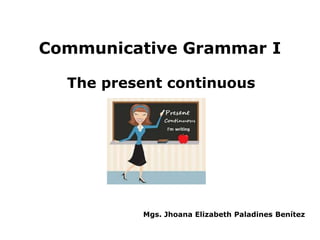
The present continuous
- 1. Communicative Grammar I The present continuous Mgs. Jhoana Elizabeth Paladines Benítez
- 2. The present continuous Se usa el presente continuo para hablar de una acción que esta sucediendo en el momento que se está hablando. El Present Progressive o Continuous es una forma verbal compuesta por el auxiliar TO BE, (am, is, are), y por un verbo terminado en ING (V+ing).
- 3. Affirmative Sentences For example: Peter is reading a book now. She is going to Basel on Saturday. His father is working in Rome this month. My friend is preparing for his exams I am reading the newspaper. He is taking a shower. We are playing tennis.
- 4. Negative Sentences La forma negativa del Present Progressive consiste en la forma negativa del verbo TO BE más el verbo principal terminado en ING. I’m not reading the newspaper. He isn’t talking a shower. We aren’t playing tennis.
- 5. Yes/ No Questions Are you reading the newspaper? Is he taking a shower? Are they playing tennis? Is Peter going to the cinema? Are they playing a game? Is she listening to the radio? Are we talking to me? Are they cleaning the windows? Is she watching the news?
- 6. Wh- Questions Where is Ashley going? To a restaurant. What is Gareth reading? The newspaper. Where is Stacey playing? In the garden. What is she wearing? A red dress. When is Mandy leaving? At nine. Who is repairing his bike? Joe. When are they are meeting? On Monday. Who is Sandy looking? Phil.
- 7. Reglas de ortografía • Cuando el verbo acaba en “e” normalmente la “e” cae delante de la terminación -ing: make – making; take – taking. • Cuando se trata de un verbo monosilábico acabado en una sola vocal seguida por una consonante, la consonante final se duplica delante de la terminación -ing: stop – stopping; sit -sitting; win – winning. • Cuando se trata de un verbo bisilábico cuya sílaba tónica es la segunda, la consonante final se dobla delante de la terminación - ing: begin – beginning; prefer – preferring.
- 8. Reglas de ortografía Pero si la sílaba tónica es la primera no existen modificaciones: visit – visiting; open – opening • No existen modificaciones cuando el verbo acaba en vocal o consonante + y: play – playing; study – studying • Los verbos acabados en -ie cambian este grupo de vocales por una y delante de la terminación - ing: die – dying
- 9. Thanks for your attention
